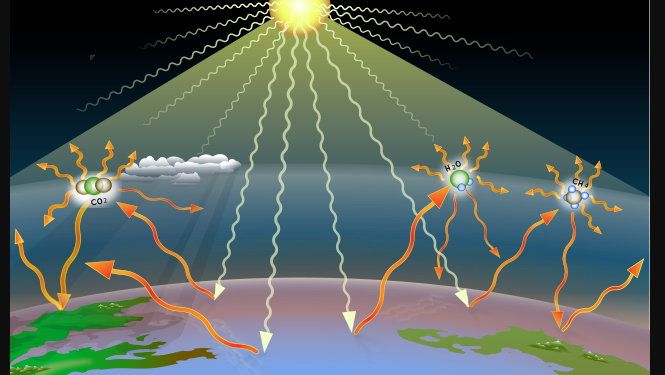When energy from the sun reaches a planet, it passes through the atmosphere and heats up the surface. The presence of greenhouse gases in the atmosphere prevents this heat from escaping back into space, making the planet warmer. This warming process is called the greenhouse effect. In this article, we’ll define the greenhouse effect, the role of greenhouse gases in the earth’s climate, and the impact of human activity on this phenomenon.
Natural warming of the earth
The greenhouse effect is a natural process that causes the Earth’s surface and lower atmosphere to warm. It is caused by the presence of greenhouse gases, such as carbon dioxide and water vapor. These substances trap the sun’s energy, allowing it to reach the ground. As a result, the earth is warmer than it would be otherwise, which increases the risk of climate change.
Carbon dioxide is one of the most potent greenhouse gases. This gas is emitted by animal and plant respiration, rice and livestock agriculture, and biomass burning. The concentration of carbon dioxide in the atmosphere has increased by more than thirty percent since the Industrial Revolution, and scientists estimate that the global average temperature will increase between three and four degrees Celsius by the end of the 21st century.
When the temperature of the Earth rises, it emits radiation upwards to balance the energy from the sun. The difference between the two temperatures is due to the presence of greenhouse gases in the atmosphere. The greenhouse gases in the atmosphere absorb this heat radiation, which causes the Earth’s atmosphere to warm. These gases also absorb infrared radiation, which warms the surface.
Influential gases that contribute to the greenhouse effect
Greenhouse gases are substances that absorb heat from the atmosphere and re-radiate it back to the Earth’s surface. These gases contribute to the global warming process and have steadily increased in concentrations since the Industrial Revolution. They are mainly produced through the burning of fossil fuels.
These gases are primarily carbon dioxide and methane. The former has a lower concentration in the atmosphere than the latter. However, its residence time in the atmosphere is far shorter than that of CO2. It stays in the atmosphere for 10 years compared to hundreds of years for CO2. Methane is a natural source and is produced through seepage vents on the seafloor in areas of high organic sediment. It is also trapped in polar permafrost. Although its concentration in the atmosphere is low, it is responsible for 16 percent of the world’s total emissions of greenhouse gases.
The greenhouse effect is caused by increasing concentrations of the following gases in the atmosphere: carbon dioxide (CO2), methane (CH4), nitrous oxide (N2O), and ozone (O3). These gases absorb sunlight, which then warms the Earth’s surface. In turn, the warmed surface radiates heat back into the atmosphere. The greenhouse effect can cause major changes in climate and environmental conditions and is a cause for concern.
Runaway greenhouse effect
The Runaway Greenhouse Effect is a phenomenon that occurs when a planet’s atmosphere becomes filled with greenhouse gases, blocking out thermal radiation. This blocks the heat that would otherwise escape the planet’s surface and prevents it from cooling. In addition, the runaway greenhouse effect means that liquid water will no longer be able to exist on the planet’s surface.
To study this phenomenon, the Ames team has used real climate information and a computer program called MODTRAN to calculate the amount of energy escaping from Earth’s top atmosphere. The model uses the amount of greenhouse gases in the atmosphere to calculate the escape rate. It also includes the presence of clouds. Using the model, the Ames team expects to further test the limits of the Runaway Greenhouse Effect.
If the runaway greenhouse effect was to occur, the amount of carbon dioxide in the atmosphere would need to rise to 30,000 parts per million. Today, it is only at about 400 parts per million. To reach 30,000 ppm, we would have to burn all fossil fuels and release the huge amounts of carbon dioxide that has been stored underground as incombustible rock. The problem with this study is that it has been difficult to create a model that is robust enough to handle such a high level of CO2.
Since the Industrial Revolution, humans have been releasing large amounts of greenhouse gases into the atmosphere. These emissions have skyrocketed over the past century, and the carbon dioxide concentration in the atmosphere has increased by about 80 percent. Burning fossil fuels has largely been responsible for this increase, and we must continue to do our part to reduce the amount of carbon dioxide in the atmosphere.
Human activities are also responsible for the emission of other greenhouse gases. While carbon dioxide is the most common, methane is a second most common greenhouse gas and accounts for about 10% of greenhouse gas emissions in the United States. It is released in natural gas and oil production and transportation, and when organic waste decomposes in landfills. Methane has a stronger warming effect than CO2 and remains in the atmosphere for a shorter period of time.
The major greenhouse gases are carbon dioxide, water vapour, methane, and nitrous oxide. These gases trap heat and radiate it back to Earth’s surface, increasing temperature and changing natural systems. The increased temperature has long-term impacts on the climate, changing weather patterns and affecting millions of people.






